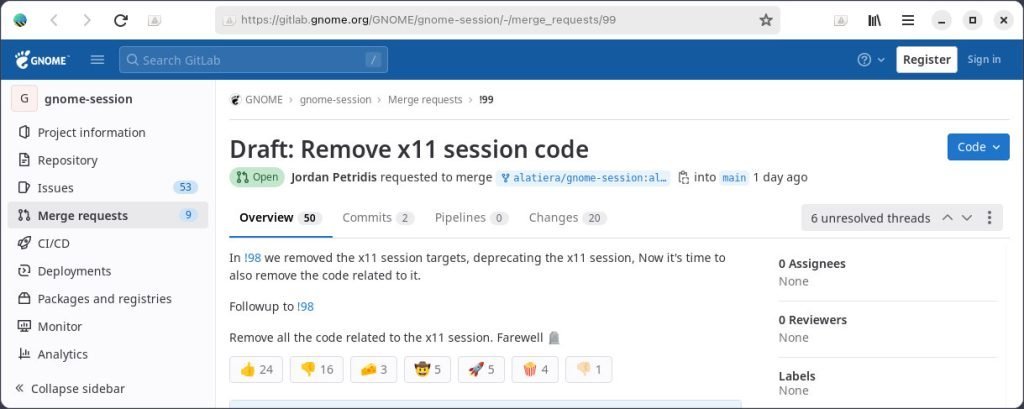GNOME, arguably the most popular Linux desktop environment, is considering dropping support for X.Org, the tried-and-true windowing system that has been a foundational element of the Linux desktop for nearly two decades.
A recent draft proposal has stirred up quite a debate among Linux users. The proposal raises some important questions about the future of Linux desktop computing.
Table of Contents
GNOME Plans to Drop X.Org
About X.Org
Before diving into the implications of this potential shift, let’s look at X.Org. X.Org is an open-source implementation of the X Window System, overseen by the X.Org Foundation, a non-profit organization. This system serves as the interface between hardware and graphical software and has been a staple in the Linux and UNIX ecosystems for many years. It’s the technology that underpins not only GNOME but also KDE and older environments like CDE.
The Rise of Wayland
Enter Wayland, a communication protocol aimed at replacing the X Window System. Developed by a Red Hat engineer in 2008, Wayland has been gaining momentum as a successor to X.Org. It boasts several advantages, including reduced input delay, smoother window resizing, enhanced performance, robust security and a streamlined code base. Many Linux distributions are already offering Wayland as the primary display protocol.
For example, Fedora Linux and Ubuntu already started offering Wayland GNOME session as default for the last couple of years. KDE Plasma desktop environment also offers default Wayland for the last few releases.
The GNOME Proposal and Its Implications
The recent draft request in GNOME GitLab to drop X.Org has sparked a lively discussion in the Linux community. While the idea of replacing an ageing technology with a more modern one seems like a logical step, it comes with its own set of challenges.
One of the main concerns is backward compatibility. Many Linux users (including non-profits, schools, etc.) still rely on older hardware that may not fully support Wayland. Completely dropping X.Org could potentially render these systems unusable for modern Linux desktops.
Not everyone is ready/capable of buying modern PCs/Laptops every five/seven years.
The Wayland Conundrum
However, it’s essential to note that Wayland is not without its issues. Despite being in development for over a decade and a half, it’s not entirely polished.
Some users have reported problems with Wayland, such as freezing with Nvidia graphics cards, limited multi-monitor support, and compatibility issues with certain applications.
For example, Nvidia graphics card owners have faced difficulties with Wayland due to graphical glitches and software crashes. Nvidia has been working on patches, but progress has been slow.
I have collected a list of issues of Wayland implementation and status at the end of this page, if you like to explore more.
Consider the User Experience
A critical aspect of this debate is the end-user experience. Linux beginners using distributions like Ubuntu and Fedora may encounter problems with Wayland, particularly on laptops with hybrid Intel/Nvidia graphics setups.
Switching to the terminal and manually installing packages isn’t a viable solution for everyone.
Moreover, some popular software tools, like screenshot utilities, screen recorders, remote desktops and image editors, are still buggy when used with Wayland. These basic functionalities can hinder the adoption of Linux among new users who often gravitate toward GNOME due to its popularity.
The Impact on Downstream Distributions
It’s not just individual users who may be affected by this potential shift.
Several Linux distributions, including elementaryOS, Xfce-based distros, and Budgie-based distros, rely on GNOME with X.Org. While they are working toward adopting Wayland, they are not yet ready to make the transition.
Of course, they have the option to package X.Org by themselves, but that comes with additional efforts and the cost of testing and regressions in every release.
The popular distribution, Linux Mint, follows a conservative approach to changes. They tend to prioritize stability and user experience. It’s possible that they will continue to package X.Org separately for years to come, ensuring a smooth transition for their users.
The Verdict
In conclusion, the idea of dropping X.Org in favour of Wayland has its merits. However, it’s crucial to consider the needs of a diverse Linux user base. An abrupt removal of X.Org could alienate users with older hardware or specific use cases.
A more balanced approach might involve keeping X.Org packaged with GNOME for several more years, with Wayland as the default. This would give users the option to switch when they are ready rather than forcing them to make manual installations.
GNOME’s success with Wayland on AMD-based systems demonstrates the potential of this transition, but the challenges for Nvidia users and certain software applications cannot be ignored.
Ultimately, the Linux desktop market is evolving, and change is inevitable. However, it’s essential to prioritize user experience and hardware compatibility during this transition. GNOME’s proposal to drop X.Org is a step forward, but it’s worth considering a more gradual change to ensure a smoother journey for all Linux users.
What is your take on this? Is it too soon? Or it’s the right time? Let me know in the comment box.
References
- Wayland Showstoppers in KDE Plasma
- GNOME Wayland issue tracker (Old)
- GNOME Wayland issue tracker (new)
- Fedora guide to debug Wayland issues
- Variable refresh rate issue in Wayland/GNOME
- Screen tearing issue
- Colours and shaders issues
- Dynamic triple/double buffering
- Inhibit idle protocol in Wayland
- Wayland status in OpenBSD
